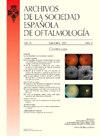双相情感障碍患者的视觉功能和视网膜结构变化
Q3 Medicine
Archivos De La Sociedad Espanola De Oftalmologia
Pub Date : 2025-07-01
DOI:10.1016/j.oftal.2025.03.007
引用次数: 0
摘要
目的主要目的是确定双相情感障碍患者的视觉功能和视网膜结构与健康受试者相比是否存在差异。材料和方法病例和对照的横断面观察研究,调整了年龄和性别。共纳入43例对照组(86只眼)和82例病例(163只眼)。采用高对比度和低对比度视力表测量最佳矫正视力(BCVA)评估视觉功能。光学相干断层扫描(OCT)模型DRI OCT triton - sweep Source (Topcon, Tokyo, Japón)用于视网膜结构分析。结果高对比度的bcva,以及2.5%和1.25%对比度降低的bcva,两组之间存在显著差异(P< 0.05),为病例组各变量的平均值。OCT分析还显示,两组患者神经纤维层(RNFL)和神经节细胞层(GCL)的平均厚度也有显著差异,病例组各变量的平均值较低(P=。007)。在I型和II型双相患者之间,这些视网膜层的平均厚度没有显著差异(P=。556和0.871)。结论双相情感障碍患者的视功能和视网膜层平均厚度与健康对照有显著差异。本文章由计算机程序翻译,如有差异,请以英文原文为准。
Alteraciones en la función visual y en la estructura retiniana de los pacientes con trastorno bipolar
Objective
The main objective is to determine if there are differences in visual function and retinal structure in patients with bipolar disorder compared to healthy subjects.
Material and methods
Cross-sectional observational study of cases and controls, adjusted for age and sex. A total of 43 controls (86 eyes) and 82 cases (163 eyes) were included. Visual function was assessed by measuring best corrected visual acuity (BCVA) using high contrast and low contrast visual charts. Optical coherence tomography (OCT) model DRI OCT Triton-Swept Source (Topcon, Tokyo, Japón) was used for retinal structural analysis.
Results
BCVA with high contrast, as well as with reduced contrast at 2.5% and 1.25%, showed significant differences (P<.05) between both groups, being the mean of each variable lower in the case group. OCT analysis also showed significant differences in the mean thickness of the nerve fiber layer (RNFL) and ganglion cell layer (GCL) between the two groups, with the mean of each variable lower in the case group (P=.007 in both). No significant differences were observed in the mean thickness of these retinal layers between type I and type II bipolar patients (P=.556 and 0.871 respectively).
Conclusions
There are significant differences in visual function and in the mean thickness of retinal layers between bipolar patients and healthy controls.
求助全文
通过发布文献求助,成功后即可免费获取论文全文。
去求助
来源期刊

Archivos De La Sociedad Espanola De Oftalmologia
Medicine-Ophthalmology
CiteScore
1.20
自引率
0.00%
发文量
109
审稿时长
78 days
期刊介绍:
La revista Archivos de la Sociedad Española de Oftalmología, editada mensualmente por la propia Sociedad, tiene como objetivo publicar trabajos de investigación básica y clínica como artículos originales; casos clínicos, innovaciones técnicas y correlaciones clinicopatológicas en forma de comunicaciones cortas; editoriales; revisiones; cartas al editor; comentarios de libros; información de eventos; noticias personales y anuncios comerciales, así como trabajos de temas históricos y motivos inconográficos relacionados con la Oftalmología. El título abreviado es Arch Soc Esp Oftalmol, y debe ser utilizado en bibliografías, notas a pie de página y referencias bibliográficas.
 求助内容:
求助内容: 应助结果提醒方式:
应助结果提醒方式:


